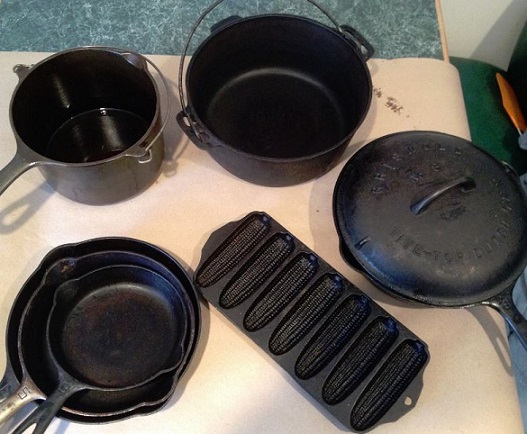
My love for Griswold cast iron cookware began about 30 years ago. For the longest time I had only the one 6″ skillet. Gradually, it dawned on me that of all my cookware, the Griswold skillet was the one I would grab again and again to cook with.
That first Griswold skillet was seasoned perfectly, so nothing stuck to it. And of course, no other cookware conducts heat as evenly as good cast iron. Whether cooking with gas or electric, I soon learned that all types of Griswold cast iron could be depended on for even cooking. And whether a batch of spaghetti sauce or a large Dutch oven of chili, sticking was never a problem.
Alas, the Griswold Manufacturing Company–an American manufacturer of cast iron home products founded in Erie, Pennsylvania–is no more. It began in 1865 and finally closed in 1957. The company had a world-wide reputation for its high-quality cast iron cookware, which today are collector’s items. A quick search on eBay shows that Griswold items, particular the more desirable or rare ones, can sell for hundreds of dollars each.
Searches at yard sales, flea markets, and such netted me a couple of nice Griswold pieces. But even at estate auctions, people know the value of it and will bid it up. (Unlike many formerly-owned cooking items, the well-seasoned cast iron that has been previously used is prized). It may be difficult to find additional pieces for a reasonable cost. Some say Wagner cast iron is just as good, but I have to disagree.
If you are in the market for Griswold, I would recommend caution when buying online. Even if the seller has a good return policy, the items are quite heavy, which make shipping expensive. (Usually, the disappointed buyer is responsible for return shipping cost).
I would recommend you buy local if at all possible. You can inspect the items personally.
Check the following:
Is the piece perfectly flat? Place it on a flat surface and push down on each side with a finger. It shouldn’t wobble at all. If it moves or wobbles, the iron has warped at some point, likely from being plunged in cold water when it was quite hot. (It CANNOT be un-warped).
Likewise, check all lids. They should fit snug and evenly all around.
Check for cracks, some of which can be quite small and hard to see, especially if there is a build-up on the iron.
Look for pitting, which is small holes or indentations in the cast iron. The Griswold Company was NOT known to sell shoddy product. If you find extensive pitting, chances are the cookware has been ill-used, or it could even be a knock-off or counterfeit product.
A very light coating of rust is acceptable, and can be removed with a steel brush. (Cast iron will rust if unseasoned and left outside). After brushing off the rust, it can be re-seasoned and will work good as new. It might also have a layer of built-up crud on it when you purchase. Again, it can be removed and your cast iron restored to good as new.
To season your cast iron, follow the easy instructions at this site: http://www.wikihow.com/Season-Cast-Iron-Cookware
Remember to always season your cast iron after each use, and store it in a dry place. It might sound like more trouble than today’s prevalent non-stick cookware, but I wouldn’t trade mine for the world!
Do a bit of research before buying. There are several good articles on the internet. Note that there were various logos used to identify the cookware. Familiarize yourself with them so you know when you have found the real thing.
Talk to the vendor. Most times, particularly if the seller has many Griswold items for sale, they know their products well and will advise you responsibly.

© Wade Kingston
